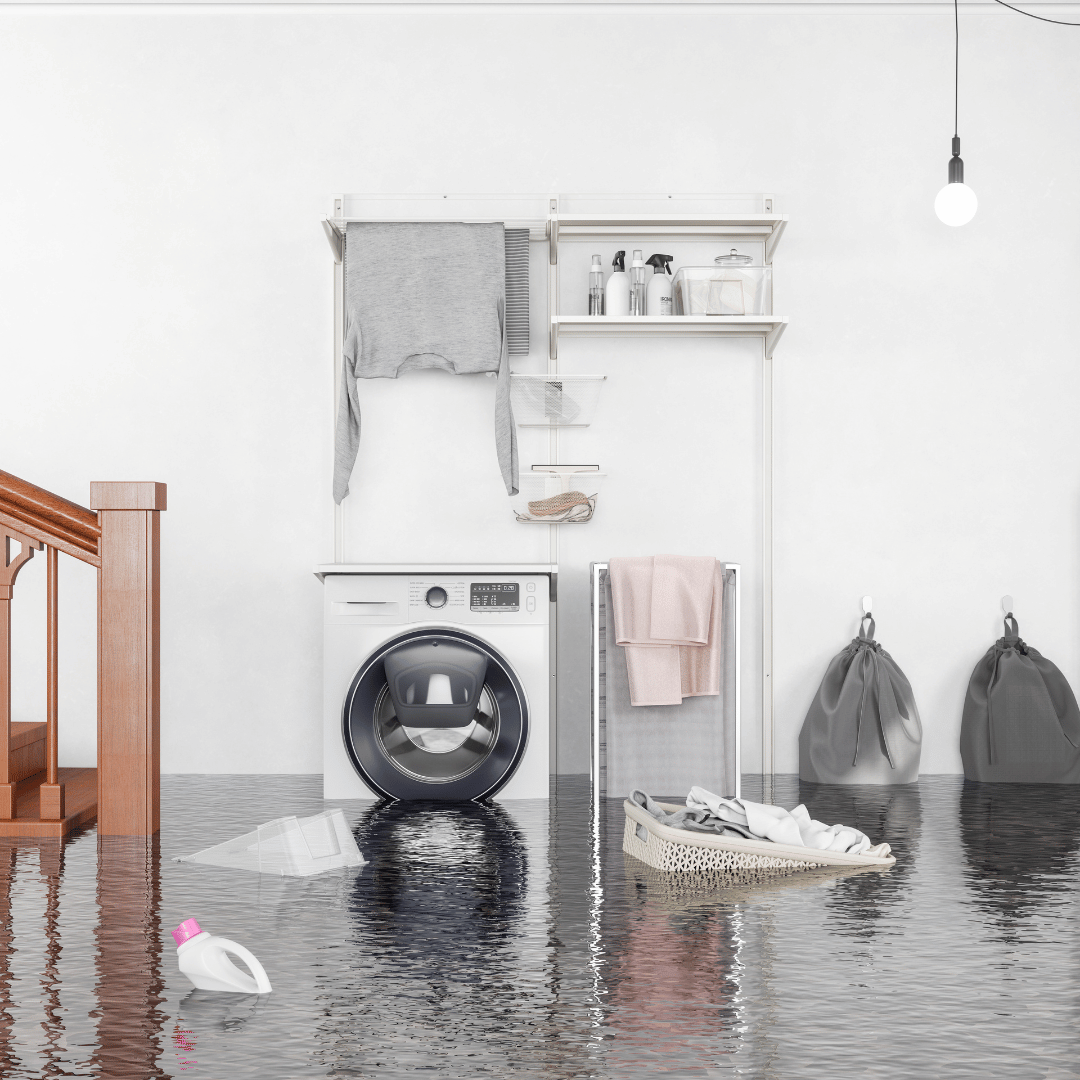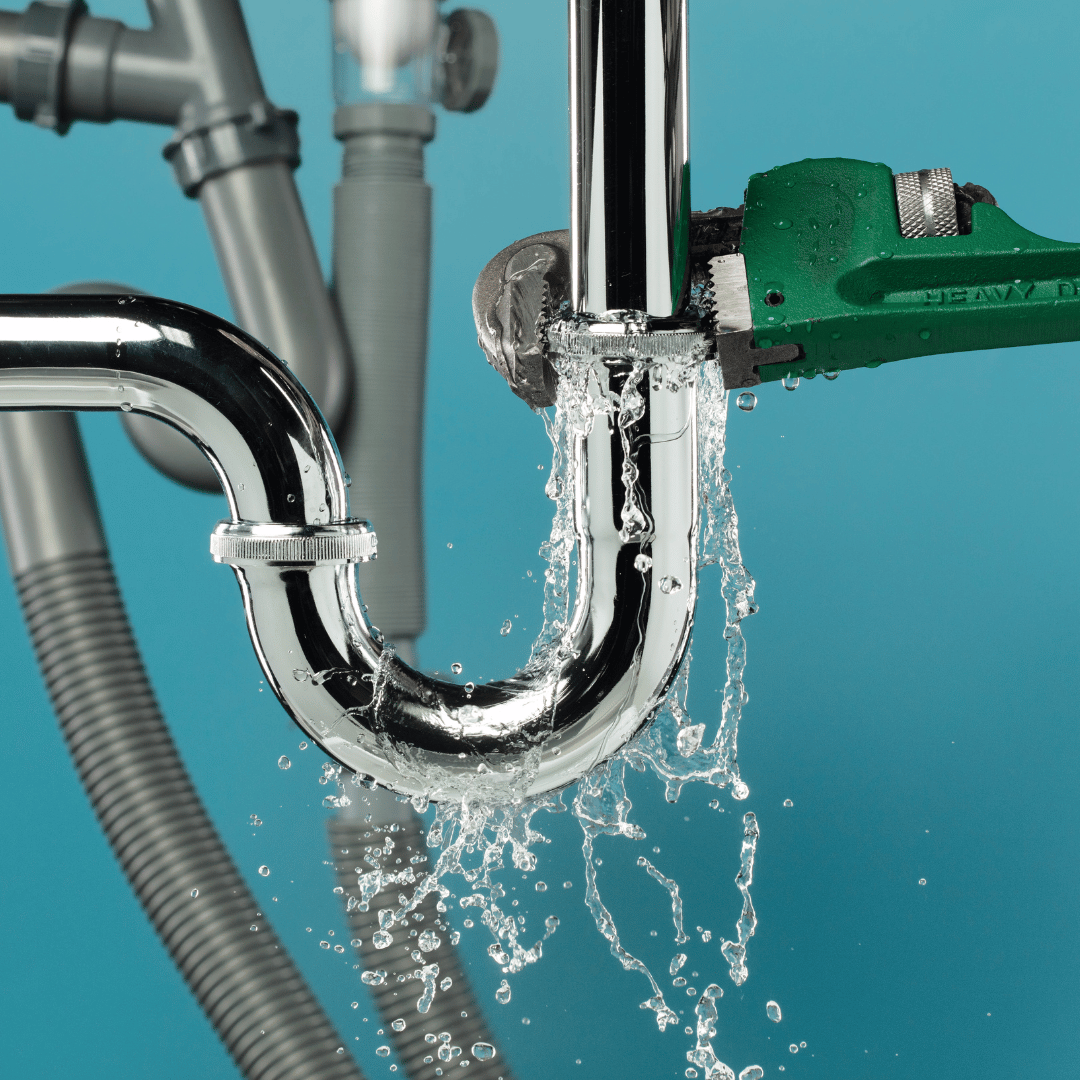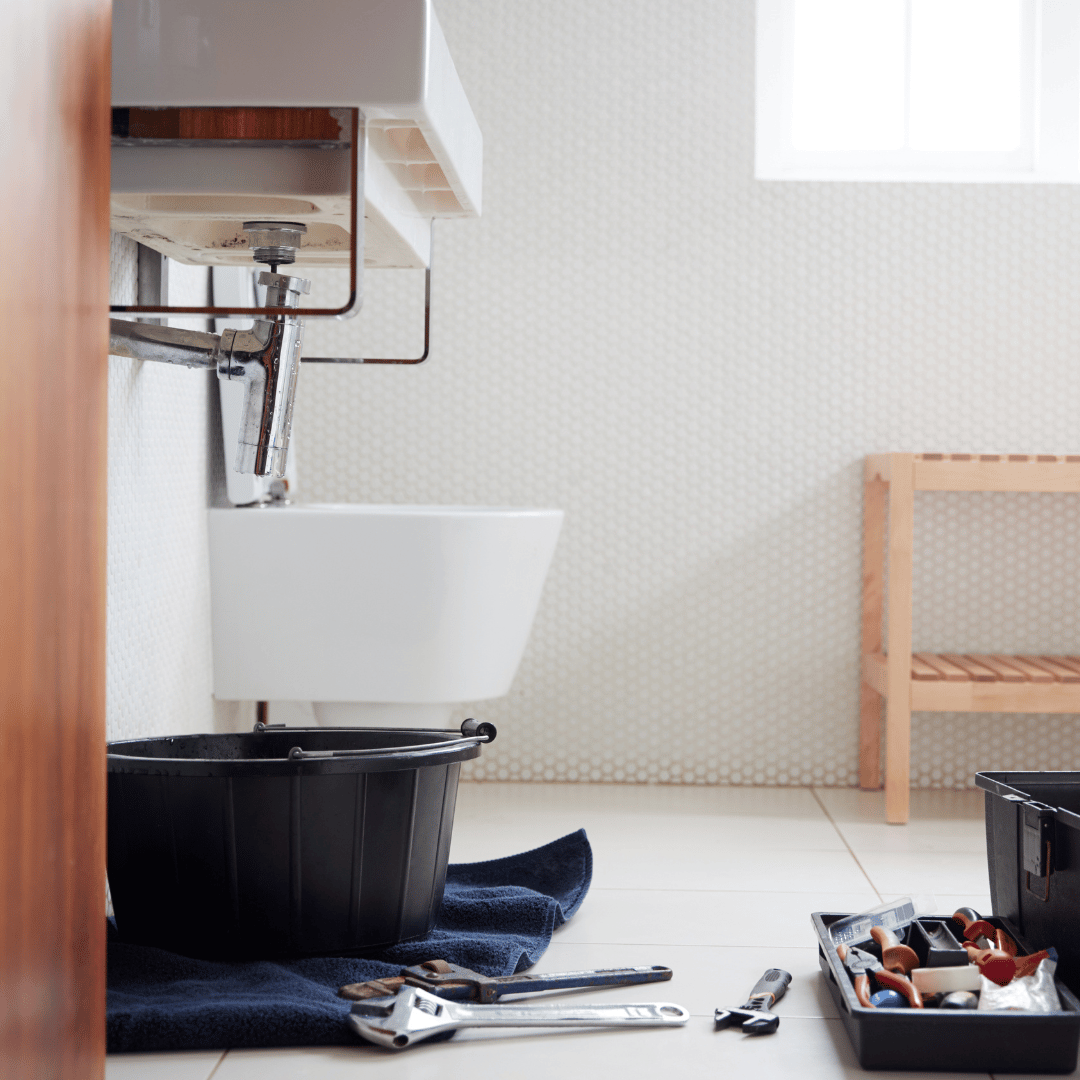A flooded basement is every homeowner’s nightmare—especially when it happens suddenly due to a sump pump failure. This critical piece of equipment is designed to keep your basement dry by redirecting water away from your foundation. But when it fails, water can back up fast—damaging flooring, drywall, appliances, and even your home’s structure.
At Larratt Bros Plumbing, we’ve seen it all. Since 1990, our founders Rob and Steve Larratt have been helping Bay Area homeowners tackle everything from emergency flooding to routine plumbing repairs, leak detection, and water heater installations. With over 30 years of experience, we understand how urgent and overwhelming a flooded basement sump pump failure can be—and we’re here to help.
In this article, we’ll walk you through:
- What to do if your sump pump fails and your basement floods
- Whether or not your insurance covers it
- How long drying takes
- The most common causes of sump pump failure
- When to treat it as an emergency
- And how long you can expect your sump pump to last
We’ll also show you how to prevent future problems—and where Larratt Bros Plumbing can assist with everything from drains, sinks, and faucets, to full water treatment & purification systems.
What to Do If a Sump Pump Fails and Your Basement Floods
When your sump pump fails and your basement starts to flood, quick action is crucial to minimizing damage. In these stressful situations, it’s important to stay calm and follow these steps:
1. Turn off Power Safely
If water is near electrical outlets, appliances, or lighting in the basement, immediately turn off the power at the main breaker. Standing water near electricity can be dangerous, so don’t take any chances. If you’re unsure, it’s best to call a professional plumber like Larratt Bros Plumbing for advice.
2. Stop Additional Water Sources
Next, shut off any water supply to the basement if flooding is caused by a burst pipe or another source of water. If the flooding is due to rain or groundwater seepage, this step may not apply, but it’s always good to check.
3. Remove Standing Water
Use a wet/dry vacuum, sump pump, or a portable pump to begin removing as much water as possible. The quicker you can remove water from the basement, the better the chances of limiting long-term damage.
If the flooding is minor, you might be able to handle it yourself. However, for more significant flooding, or if you’re unsure about how to proceed, don’t hesitate to call a professional plumber for assistance. Larratt Bros Plumbing has the right tools to handle even the most severe flooding.
4. Dry Out the Area
Once the water is removed, start drying out the space. Open windows, set up fans, and use dehumidifiers to speed up the drying process. Drying your basement quickly is essential not just to prevent mold growth but to protect your plumbing system, including drains, faucets, showers, and even your water heater if the water has reached these areas.
5. Contact a Professional Plumber
Once you’ve taken initial steps to control the flooding, it’s time to get your sump pump system inspected. The failure of your pump is likely due to a bigger issue that needs professional attention, whether it’s a mechanical malfunction, a power issue, or an improperly installed system.
At Larratt Bros Plumbing, we offer plumbing repairs, sewer line inspections, and leak detection services to ensure your system is fully functional and prevent future failures.
Does Flood Insurance Cover Sump Pump Failure?
When your sump pump fails and your basement floods, one of the first questions you might ask is whether your flood insurance will cover the damage. Unfortunately, the answer isn’t always straightforward.
Standard Homeowner’s Insurance: What It Covers
Most standard homeowner’s insurance policies cover sudden and accidental damage caused by events like a burst pipe or fire. However, sump pump failure typically falls outside of that coverage, as it’s generally classified as a mechanical failure—not a covered peril under most basic policies.
Flood Insurance: What It Covers
Flood insurance generally covers damage caused by rising water, such as that from heavy rainfall or overflowing rivers. While it’s essential for flood-prone areas, flood insurance typically doesn’t cover sump pump failures directly. If the water in your basement is caused by a sump pump backup due to mechanical failure, you may not be able to rely on this type of policy to cover the damage.
Water Backup Endorsements: A Possible Solution
To protect against sump pump failure and water backup, many homeowners can add a water backup endorsement to their existing homeowner’s insurance. This coverage is designed to cover damage from backed-up drains, sewers, or sump pumps. However, this optional rider must be added to your policy ahead of time—so it’s important to check with your insurance agent before disaster strikes.
What Does This Mean for Your Plumbing Systems?
If you’re worried about flooding due to sump pump failure, you may want to review the coverage for other plumbing systems in your home, like water heaters, faucets, toilets, and sinks. Some insurance policies offer protection for water damage caused by these systems if they’re covered under an emergency plumbing issue.
Take Action: Speak to Your Insurance Provider
In summary, flood insurance won’t likely cover sump pump failure unless you’ve specifically added a water backup rider. It’s important to talk with your insurance provider to ensure you’re adequately protected against sump pump failures and other plumbing issues.
Additionally, if you haven’t already, it’s a good idea to schedule regular plumbing repairs and maintenance to reduce the risk of problems with your sump pump and other key plumbing systems. Larratt Bros Plumbing can assist with routine drain maintenance, sewer inspections, water heater repairs, and leak detection, helping to keep your home protected.
How Long Does It Take for a Flooded Basement to Dry Out?
Once your sump pump fails and your basement floods, the next step is to get the space dried out as quickly as possible. The longer water sits, the more damage it can cause—especially to your plumbing systems, flooring, walls, and belongings. But how long will it actually take to dry out your flooded basement?
Drying Time Based on Severity
The time it takes to dry out a flooded basement depends largely on the amount of water that has flooded the space and how quickly you can remove it. Here’s a general breakdown:
- Minor Flooding (1–2 inches of water): If the flooding is relatively shallow, it may take 24–48 hours to dry out completely. In this case, a wet/dry vacuum and dehumidifiers may be enough to remove the moisture.
- Moderate Flooding (3–6 inches of water): If the flooding is more significant, expect the drying process to take about 3–5 days. This often requires more powerful equipment like sump pumps and industrial fans to dry the area effectively.
- Severe Flooding (6+ inches of water): For major flooding, particularly if the water has reached plumbing systems like toilets, sinks, or water heaters, it can take up to 1–2 weeks or longer to fully dry out the space. At this point, professional help from a plumber and water damage restoration service is often required.
The Role of Dehumidifiers and Fans
Once the bulk of the water is removed, it’s important to use fans and dehumidifiers to dry the air and reduce humidity levels. These devices help prevent mold growth, which can begin within 24–48 hours in a damp environment. Without proper drying, your basement could become a breeding ground for mold and mildew, which can damage walls, drains, and other plumbing fixtures.
The Impact of Standing Water on Plumbing
Standing water can have a significant impact on your plumbing systems, including sewers, drain lines, and other appliances like water heaters and faucets. It’s essential to inspect these systems after the floodwaters recede to ensure they’re functioning properly and haven’t been compromised. Failure to do so can lead to future plumbing issues, such as clogged drains or water contamination.
Professional Help for Faster Drying
If you’re unsure about how to speed up the drying process or need help assessing potential damage to your plumbing, it’s always best to reach out to professionals. At Larratt Bros Plumbing, we specialize in leak detection, water heater repair & installation, and full plumbing system inspections. We’ll ensure that everything, from your sump pump to your drains, is in good condition and ready for future use.
What Is the Most Common Reason for Sump Pump Failure?
Sump pumps are vital for preventing basement flooding, but like any mechanical system, they can fail. Understanding the common reasons behind sump pump failure can help you prevent future issues and ensure your system is running smoothly when you need it most.
1. Power Failure
One of the most common reasons for sump pump failure is a power outage. If the pump loses power, it can no longer remove water from the sump pit, leading to a flooded basement. This is especially problematic during storms or heavy rain when power outages are more frequent.
Solution:
Consider installing a battery backup sump pump or a generator to ensure your pump continues to operate during power outages. This small investment can prevent extensive damage to your home and plumbing systems.
2. Clogged or Frozen Discharge Line
Another frequent cause of failure is a clogged discharge line. Over time, debris, dirt, and leaves can accumulate in the discharge pipe, preventing water from being properly expelled from your basement. In colder climates, freezing temperatures can cause the discharge line to freeze, which prevents water from being pumped out.
Solution:
Regularly clean the discharge line to remove debris, and insulate the line if you live in an area prone to freezing. Also, ensure that the discharge point directs water away from your foundation.
3. Mechanical Failure
Mechanical issues, such as worn-out parts or a malfunctioning switch, can also cause a sump pump to fail. Pumps that are overused without proper maintenance can wear out faster, leading to mechanical failure. In many cases, this issue can be traced back to inadequate maintenance or aging equipment.
Solution:
Schedule routine plumbing repairs and maintenance to check your sump pump’s condition, including leak detection and inspection of key components like the pump switch and float. Replacing worn parts before they break down can extend the life of your sump pump.
4. Improper Installation
If your sump pump was not properly installed, it might fail at critical times. Common installation issues include a poorly sized pump, incorrect discharge routing, or improper sealing, all of which can lead to pump failure or poor performance.
Solution:
Have a professional plumber, like Larratt Bros Plumbing, install and inspect your sump pump. Ensuring that the pump is the correct size for your basement and that the installation meets local code requirements can prevent future problems.
5. Lack of Maintenance
Just like other home plumbing systems—faucets, toilets, showers, and bathtubs—your sump pump requires regular attention to keep it functioning well. Many homeowners neglect their sump pumps until a failure occurs, leaving them unprepared when the worst happens.
Solution:
Perform annual maintenance on your sump pump system. Test it regularly by pouring water into the sump pit to ensure it activates and pumps water out. Clean the pump and pit to prevent sediment build-up, and inspect the system for any visible damage or wear.
Final Thoughts on Sump Pump Failure Prevention
By understanding the most common causes of sump pump failure and taking preventive action, you can protect your basement from flooding and avoid costly repairs. Regular maintenance, upgrading components, and proper installation are key to ensuring your sump pump works when it’s needed most.
At Larratt Bros Plumbing, we specialize in sump pump installations, plumbing repairs, and routine inspections. Whether you’re dealing with an old system or need a new installation, our team can ensure your system runs efficiently to prevent flooding and protect your home.
Is Sump Pump Failure an Emergency?
When a sump pump failure occurs, it’s more than just a minor inconvenience—it can quickly escalate into a plumbing emergency, especially if it leads to basement flooding. Understanding why sump pump failure is considered an emergency and how quickly it needs to be addressed can help you prevent significant damage to your home and belongings.
Why Sump Pump Failure Is an Emergency
A sump pump serves a critical role in keeping your basement dry by diverting water away from your foundation. When the pump fails, water can quickly accumulate, flooding your basement and potentially damaging the structure of your home. In addition to water damage, the following issues can arise if you don’t address the failure immediately:
- Mold Growth: Standing water in your basement can promote mold and mildew growth, which can be hazardous to your health and costly to remove.
- Damage to Plumbing Systems: If water reaches your sewer lines, drains, or other plumbing systems, it can cause clogs, corrosion, or leaks, which may require costly repairs.
- Electrical Hazards: Water near electrical outlets, appliances, or wiring can create dangerous conditions, posing a risk of electrocution or electrical fires.
When to Treat Sump Pump Failure as an Emergency
In general, you should treat sump pump failure as an emergency if:
- You have significant water accumulation: If the water in your basement is rising quickly and threatening your belongings or the structural integrity of your home, immediate action is necessary.
- Your basement contains valuable or irreplaceable items: If your basement holds important documents, furniture, or electronics, it’s critical to address the flooding immediately to minimize damage.
- Water is near electrical systems: As mentioned, water near electricity can be dangerous. If flooding affects your home’s electrical systems, it’s essential to turn off the power and contact a plumber and electrician right away.
How to Handle a Sump Pump Emergency
If your sump pump fails and you experience flooding, follow these steps to mitigate the damage:
- Shut off the power: If water is near electrical outlets or equipment, turn off the main power supply to avoid the risk of electrocution.
- Stop the water source: If possible, try to identify the source of the water and stop it (e.g., turn off the water supply if the flooding is due to a burst pipe).
- Remove the water: Use a wet/dry vacuum, portable pump, or sump pump to start removing the water. The sooner you can get the water out of the basement, the less damage will occur.
- Call a professional: A plumbing expert from Larratt Bros Plumbing can quickly assess the situation, repair or replace your sump pump, and ensure your drains, sewers, and other plumbing systems are functioning properly to prevent further issues.
Is Sump Pump Failure an Emergency for You?
If you’re unsure whether your sump pump failure is an emergency, err on the side of caution and call a plumber immediately. At Larratt Bros Plumbing, we offer emergency plumbing services for sump pump repairs and replacements. Our team is available to handle urgent issues 24/7, ensuring that you can get the help you need, fast.
What Is the Average Life of a Basement Sump Pump?
A basement sump pump is a hardworking appliance designed to keep your home dry and prevent flooding. Like any mechanical system, however, it has a lifespan—and understanding how long your sump pump should last is crucial for preventing unexpected failures and keeping your home safe from water damage.
Typical Lifespan of a Sump Pump
On average, a sump pump lasts about 7 to 10 years. However, the actual lifespan can vary depending on several factors, including the quality of the pump, how often it’s used, and how well it’s maintained. Regular maintenance can extend the life of your pump, while neglect can shorten it.
Factors Affecting Sump Pump Lifespan:
- Usage Frequency: If you live in an area prone to heavy rainfall or flooding, your sump pump will likely run more frequently, which can cause it to wear out more quickly. Similarly, if your pump is located in an area with high water table levels, it may be more active, leading to a shorter lifespan.
- Pump Quality: Not all sump pumps are created equal. Higher-quality, more durable pumps may last longer than cheaper models. It’s essential to choose a sump pump that suits your needs and the size of your basement.
- Maintenance: A well-maintained pump will last longer than one that is neglected. Regular checks, cleanings, and part replacements can prevent sump pump failure. For example, drains can get clogged with debris, and the pump itself can suffer from sediment buildup if not cleaned regularly.
- Installation Quality: Proper installation is crucial for a long-lasting sump pump. If your pump was incorrectly sized, poorly installed, or not connected properly, it could fail much sooner than expected.
Signs Your Sump Pump May Be Near the End of Its Life
While the average lifespan of a sump pump is 7 to 10 years, there are several signs that may indicate your pump is nearing the end of its useful life:
- Frequent cycling: If your pump is turning on and off more often than usual, it may be struggling to keep up with water levels, suggesting that it’s worn out.
- Loud noises: If your pump is making unusual sounds, like grinding or buzzing, it could be a sign of internal mechanical issues.
- Ineffective drainage: If the sump pump no longer effectively removes water from your basement, it could be clogged or damaged.
- Older age: If your pump is approaching 10 years old or more, it’s a good idea to start thinking about a replacement.
How to Extend the Life of Your Sump Pump
To maximize the lifespan of your sump pump, regular maintenance is essential. Here are some helpful tips:
- Test your pump regularly: Pour water into the sump pit and make sure the pump activates and drains the water effectively. This ensures the pump is working properly and can handle the load during heavy rainfall.
- Clean the sump pit: Periodically clean out debris, dirt, and sediment from the sump pit to prevent clogging and ensure smooth operation.
- Check the discharge line: Make sure the discharge line is free of obstructions and directs water away from your home’s foundation.
- Consider upgrading: If your pump is old, upgrading to a newer model can give you peace of mind and better performance.
When to Replace Your Sump Pump
If your sump pump is nearing the end of its lifespan or showing signs of failure, it’s time to think about a replacement. At Larratt Bros Plumbing, we specialize in sump pump installations and replacements. Our team can assess the condition of your pump, help you choose the best replacement, and install it properly to ensure your basement stays dry for years to come.
The average lifespan of a basement sump pump is typically 7 to 10 years, but factors like usage, quality, and maintenance can affect how long your pump lasts. Regular testing and maintenance are key to preventing unexpected failures. If you notice any signs of wear, it’s a good idea to have your sump pump inspected by a professional plumber to avoid a flooded basement and potential damage to your home.
Larratt Bros Plumbing is here to help with sump pump installations, repairs, and inspections. Contact us today to ensure your sump pump is working efficiently and ready to protect your home.
Protect Your Home from Sump Pump Failures
A flooded basement due to sump pump failure is a stressful and potentially damaging event. However, by understanding the common causes of sump pump failure, how to address a flooded basement, and the importance of regular maintenance, you can take proactive steps to prevent extensive damage to your home.
At Larratt Bros Plumbing, we have over 30 years of experience helping homeowners in the Bay Area tackle everything from plumbing repairs to sump pump installations and replacements. We know that a sump pump failure is more than just an inconvenience—it’s an emergency that needs immediate attention to prevent further water damage, mold growth, and long-term plumbing issues.
To recap, here are a few key takeaways:
- What to do if your sump pump fails: Act quickly by turning off the power, stopping water sources, removing standing water, and calling a professional plumber.
- Does flood insurance cover sump pump failure?: Most standard flood insurance policies don’t cover sump pump failure, but adding a water backup endorsement could help.
- How long does it take to dry a flooded basement?: The drying process can take anywhere from 1-2 days for minor flooding to over a week for severe flooding.
- What is the most common reason for sump pump failure?: Power failure, mechanical issues, clogged discharge lines, and improper installation are common causes.
- Is sump pump failure an emergency?: Yes, it’s an emergency, especially if the water is rising quickly or affecting electrical systems.
- What is the average life of a basement sump pump?: Typically, a sump pump lasts 7 to 10 years, depending on usage and maintenance.
Regular inspections, maintenance, and upgrades to your sump pump, drains, and water heater systems can help prevent failures and ensure that your plumbing systems are functioning at their best. If you’re experiencing a sump pump failure or need plumbing repairs, don’t hesitate to contact Larratt Bros Plumbing. We’re here to help with everything from toilet repairs, bathtub installations, and garbage disposal installations, to sewer inspections, and water treatment & purification services.
Don’t wait for the next flood—contact Larratt Bros Plumbing today for expert sump pump services and plumbing solutions. Call us now at (650)873-5794 or fill out our online contact form to schedule an inspection. Our team is ready to keep your home dry, safe, and protected.





